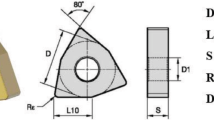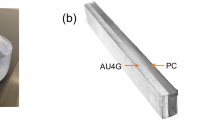Abstract
This paper aims to study the behavior of machining forces and machined surface finish when micro-turning PA66-GF30-reinforced polyamide with various tool materials under distinct cutting conditions. The performance of polycrystalline diamond (PCD), CVD diamond coated carbide and plain cemented carbide tools (K15-KF and K15) were investigated in addition to the influence of feed rate on cutting forces, surface roughness and chip formation. The results indicated that the radial force was the highest force component because of the reduction in the effective cutting edge angle. Moreover, the cutting force increased almost linearly with feed, whereas the feed and radial forces remained unaltered. The cutting tools possessing lower edge radius promoted lower surface finish and turning forces, i.e., the best results were provided by the PCD tool, followed by the uncoated carbide inserts and finally by the CVD diamond-coated carbide tool.
Similar content being viewed by others
References
Gopala GV, Mahajan P, Bhatnagar N (2007) Micro-mechanical modeling of machining of FRP composites - cutting force analysis. Compos Sci Technol 67:579–593 DOI 10.1016/j.compscitech.2006.08.010
Sonbaty E, Khashaba U, Machaly T (2004) Factors affecting the machinability of GFR/epoxy composites. Compos Struct 63:329–338 DOI 10.1016/S0263-8223(03)00181-8
Rahman M, Ramakrishna S, Prakash JR, Tan DC (1999) Machinability study of carbon fiber-reinforced composite. J Mater Process Technol 89–90:292–297 DOI 10.1016/S0924-0136(99)00040-0
Wang XM, Zhang LC (2003) An experimental investigation into the orthogonal cutting of unidirectional fiber-reinforced plastics. Int J Mach Tools Manuf 43:1015–1022 DOI 10.1016/S0890-6955(03)00090-7
Abrão AM, Faria PE, Campos Rubio JC, Reis P, Davim JP (2007) Drilling of fiber-reinforced plastics: a review. J Mater Process Technol 186:1–7 DOI 10.1016/j.jmatprotec.2006.11.146
Davim JP, Reis P, Lapa V, António C (2003) Machinability study on polyetheretherketone (PEEK) unreinforced and reinforced (GF30) for applications in structural components. Compos Struct 62:67–73 DOI 10.1016/S0263-8223(03)00085-0
Davim JP, Reis P (2004) Machinability study on composite (polyetheretherketone reinforced with 30% of glass fiber-PEEK GF30) using polycrystalline diamond (PCD) and cemented carbide (K20) tools. Int J Adv Manuf Technol 23:412–418 DOI 10.1007/s00170-003-1779-7
Mata F, Reis P, Davim JP (2006) Physical cutting model of polyamide composites (PA66 GF30). Mat Sci Forum 514–516:643–647
Kim KW, Lee WY, Sin H (1999) A finite element analysis for the characteristics of temperature and stress in micro-machining considering the size effect. Int J Mach Tools Manuf 39:1507–1524 DOI 10.1016/S0890-6955(98)00071-6
Yuan ZJ, Zhou M, Dong S (1996) Effect of diamond tool sharpness on minimum cutting thickness and cutting surface integrity in ultraprecision machining. J Mater Process Technol 62:327–330 DOI 10.1016/S0924-0136(96)02429-6
Kang IS, Kim JS, Kim JH, Kang, Kang MC, Seo YW (2007) A mechanistic model of cutting force in the micro end milling process. J Mater Process Technol 187–188:250–255 DOI 10.1016/j.jmatprotec.2006.11.155
Dornfeld D, Min S, Takeuchi Y (2006) Recent advances in mechanical micromachining. Ann CIRP 55/2:745–768
Simoneau A, Ng E, Elbestawi MA (2006) Surface defects during microcutting. Int J Mach Tools Manuf 46:1378–1387 DOI 10.1016/j.ijmachtools.2005.10.001
Fang FZ, Liu YC (2004) On minimum exit-burr in micro cutting. J Micromechanics Microengineering 14:984–988 DOI 10.1088/0960-1317/14/7/020
Azizur Rahman M, Rahman M, Senthil Kumar A, Lim HS (2005) CNC microturning: an application to miniaturization. Int J Mach Tools Manuf 45:631–639 DOI 10.1016/j.ijmachtools.2004.10.003
Boothroyd G (1981) Fundamentals of metal machining and machine tools. Mc Graw Hill Int. Book Co
Author information
Authors and Affiliations
Corresponding author
Rights and permissions
About this article
Cite this article
Silva, L.R., Davim, J.P., Festas, A. et al. Machinability aspects concerning micro-turning of PA66-GF30-reinforced polyamide. Int J Adv Manuf Technol 41, 839–845 (2009). https://doi.org/10.1007/s00170-008-1537-y
Received:
Accepted:
Published:
Issue Date:
DOI: https://doi.org/10.1007/s00170-008-1537-y




